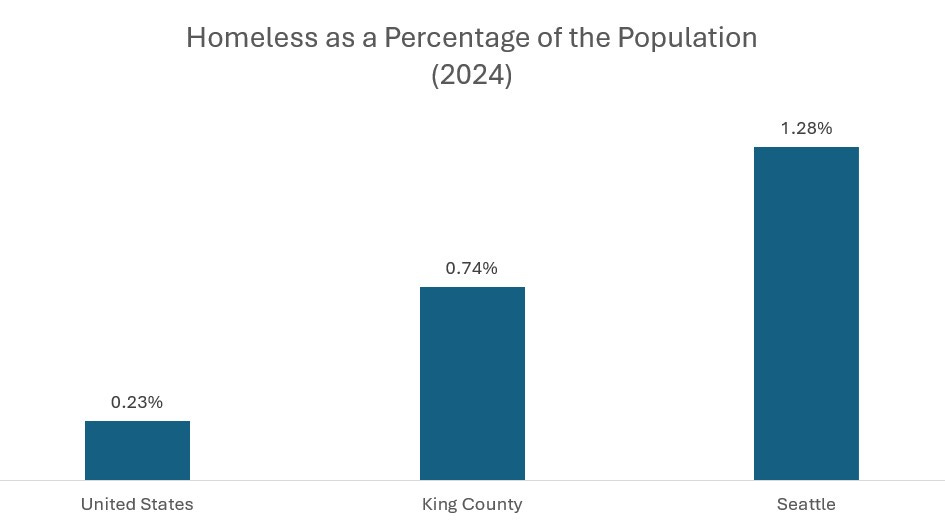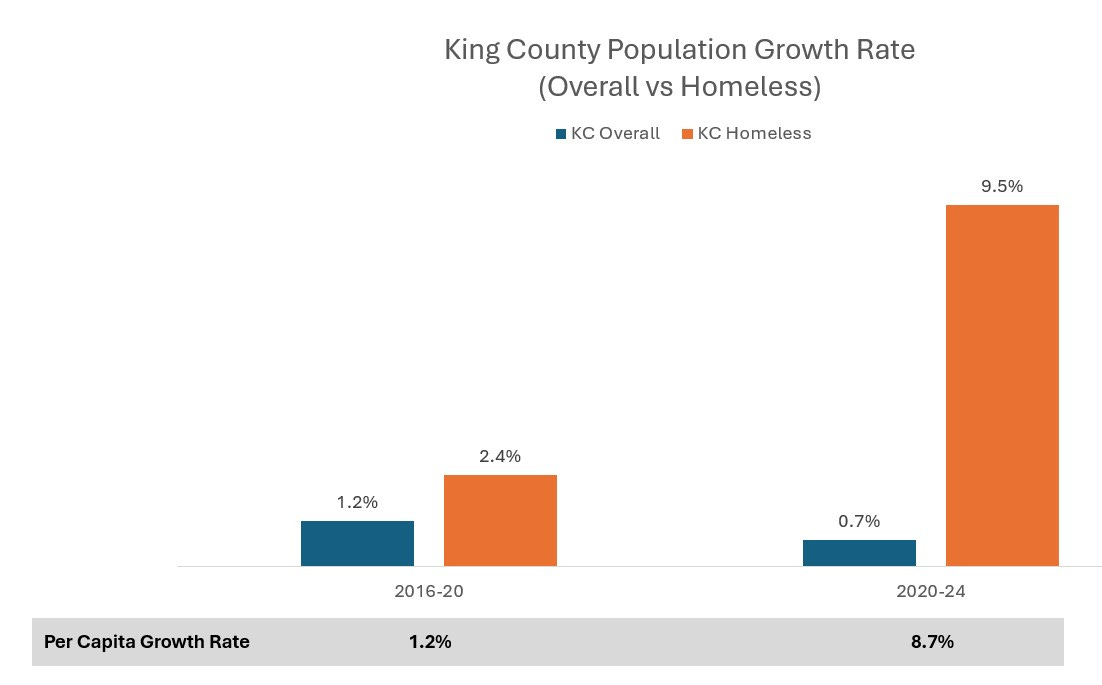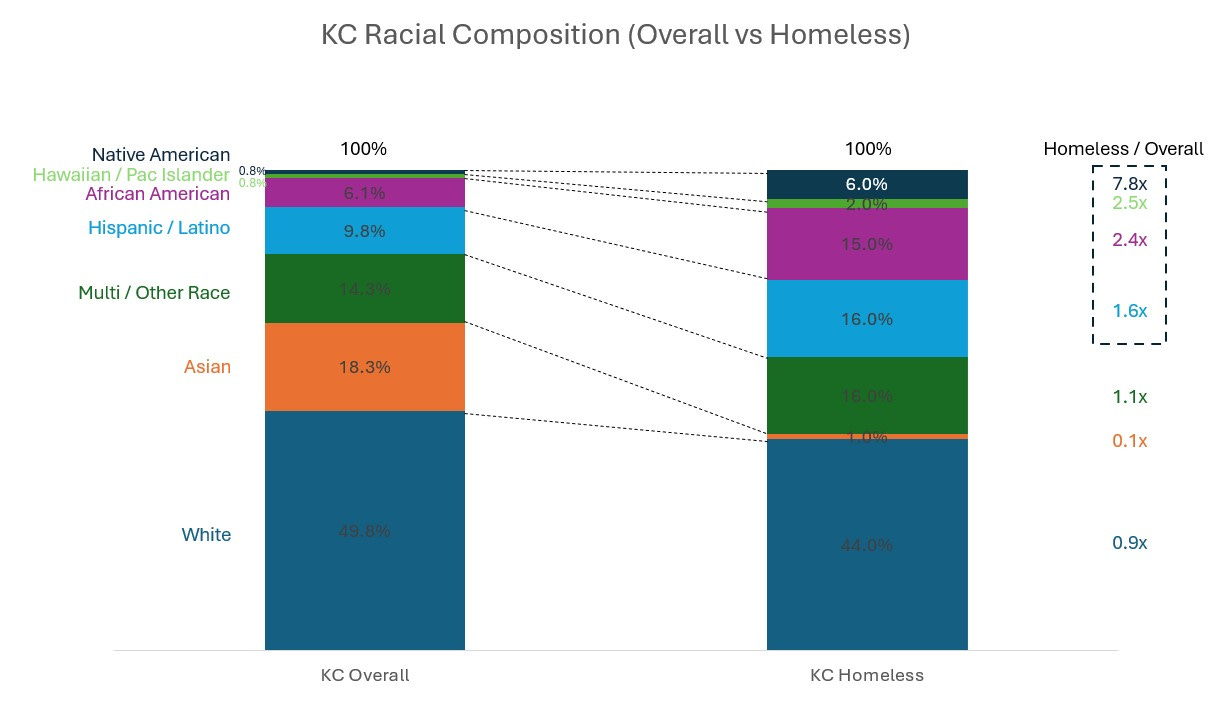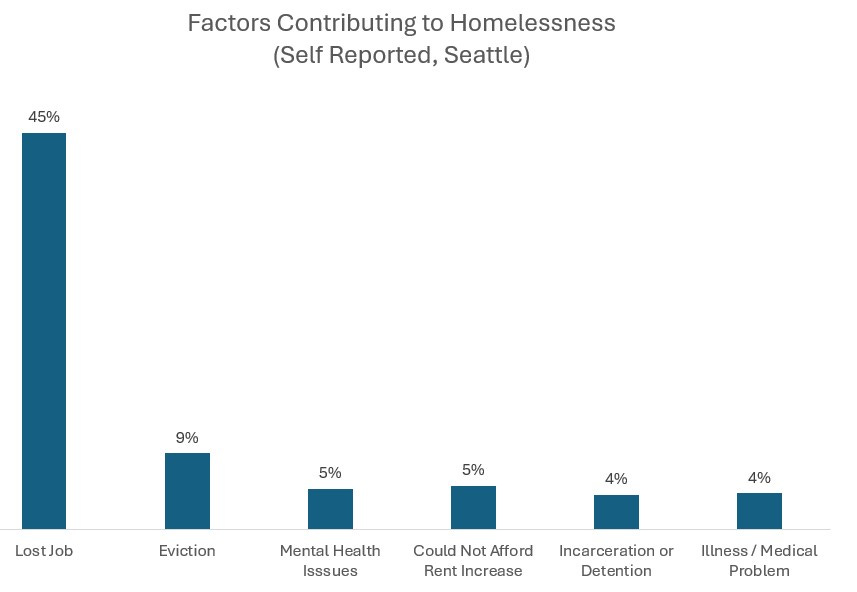Portrait of Seattle's Homeless
...302 days to go...
“Seek first to understand, and only then to be understood”
- Stephen Covey, The 7 Habits of Highly Effective People (habit #5)
In my business career, I’ve always tried to live by the maxim above, since trying to help someone without first fully understanding their needs usually doesn’t work.
At the start of this project I knew even less about the homeless than I knew about most of my clients’ businesses at the start of a consulting project. So I decided to do some research into a question many readers have asked me in some form or another: just who are all of these homeless people, anyway?
Having a baseline understanding of Seattle’s homeless population will help inform some of my efforts, and I’m sharing statistics below in case it helps others, too.
Most of the data below comes from the King County Regional Homelessness Authority (KCRHA) 2024 Point in Time Count (summary, detail), which was conducted in January 2024. When possible I’ll provide figures for Seattle specifically, but more often they will be for King County, which includes Seattle but is about three times as large (Seattle includes 736K people while King County includes 2.23M).
Scale
According to the KCRHA, there were 9,440 homeless people in Seattle in January 2024. That’s about 1.3% of Seattle’s population. Widening our aperture, King County has 16,868 homeless people, which is 0.7% of its population. And the US as a whole has about 771,000 homeless people out of 340 million individuals: about 0.2% of its population overall. So Seattle has about six times the per capita rate of homelessness as the nation overall.
It’s important to note that point in time counts are widely acknowledged to underestimate the problem of homelessness, because they miss people who are temporarily homeless during the year - just not on the night of the count. For example, King County estimated that for every person counted in its 2011 point in time count, about 3.5 people were homeless at some point during the year.
If we apply this 3.5x undercount factor to Seattle in 2024, we get about 32,833 people who experienced homelessness at some point during the year, which is actually about 4.5% of our population. Almost one in 20.
Growth
Our homeless population has basically exploded during the pandemic. KCRHA posts its point in time counts going back to 2016. Adjusted for growth in King County’s population, the county’s per capita rate of homelessness grew 1.2% per year from 2016-2020, and 8.7% per year from 2020-2024.
The implications are pretty frightening: if the growth rate of the last four years continues, about 7.4% of Seattleites would be homeless at some point in 2030!
Sadly, there are flashing red warning signs that the growth in homelessness will continue. Since the start of the pandemic, the federal government has been providing Emergency Rental Assistance Programs which have distributed over $46 billion for the payment of rent and utilities. This program will end on September 30th of this year, which will certainly tip additional Seattleites into homelessness. Additionally, the passage of the “One Big Beautiful Bill” will cut $186 billion from the Supplemental Nutrition Assistance Program through 2034 according to estimates from the Congressional Budget Office, approximately a 20% reduction in the program. These cuts will certainly also tip new Seattleites into homelessness by forcing precariously housed individuals to divert money into groceries that might otherwise have been used for housing.
Living Conditions
The point in time count divides homeless people into two categories. Seattle’s 4,855 ‘Sheltered’ homeless (51% of the point-in-time total) include those living in shelters, micro dwellings such as tiny homes, hotels or motels, and transitional programs (lodging designed to be temporary).
Seattle’s 4,585 ‘Unsheltered’ homeless (49% of the point-in-time total) include those residing in places not meant for human habitation, including vehicles, streets, sidewalks, parks, abandoned buildings, encampments, or other outdoor spaces.
Sheltered homeless are often homeless for a much shorter period of time than unsheltered homeless. This means that sheltered individuals are much more likely to be undercounted, and, therefore, sheltered individuals comprise much more than 50% of the total number of people who are homeless at some point during the year. But while the unsheltered population is smaller as a percentage, it is much more visible to most of us than the sheltered population.
Family Units
In King County there are 1,959 homeless kids under the age of 18. As I wrote recently, only about 600 of these kids (less than a third) are in shelters. The rest are in Tiny Homes, tents, living out of cars, or worse.
It’s worth mentioning that these numbers exclude families temporarily living ‘doubled-up’ with others. This is a pretty common arrangement among families, and some estimates by the Department of Education indicate these could roughly quadruple the number of kids we count as homeless, even before factoring in the undercount discussed above.
I’ve met these kids visiting Tent City 4 in Lake City. In the ~50 tent encampment, families were a pretty common site. It was heartbreaking not just watching them navigate life in a tent, but realizing our city was actively uprooting them at regular intervals, preventing the appearance of even the most basic of roots.
This gets personal for me, because as a divorced parent, I know it’s hard for Natalie when she transitions from my house to her mom’s house and back. I can’t imagine how distracting and deflating it would be for her to live in a house that is not her own or in a shelter.
Gender
About two-thirds of King County’s homeless are male, and about one-third are female.
Race
Comparing King County’s homeless to its overall population, I expected certain racial categories to be over-represented given our history of systemic racism. But I was blown away by the magnitude of the discrepancies.
In general, Hispanics are 1.6x more likely to be homeless in Seattle than the general population. African Americans are 2.4x more likely to be homeless, Hawaiians / Pacific Islanders are 2.5x more likely, and Native Americans are a whopping 7.8x more likely to be homeless.
Contributing Conditions
I’m often asked what causes homelessness. Typically people are trying to understand whether the primary issue is economic hardship (e.g., lost job, broken-down car) or mental health / substance abuse.
One reason this is so tricky to answer, as the authors of Homelessness is a Housing Problem have pointed out, is that the overall rate of homelessness in a particular city or county cannot be predicted based on either the number of cases of economic hardship OR the prevalence of mental illness / substance abuse in that area. The best predictor of a location’s rate of homelessness is actually the cost of housing in that area. This means that while economic hardships or mental health/substance abuse may determine which individuals in an area become homeless, neither determines how many individuals in the area become homeless. (Please consider reading the book - I have not done it justice here).
That said, I think it is still important to understand which individuals in Seattle are becoming homeless, so we can look at this data. In fact, different surveys provide very different results here.
As you can see in the chart above, according to King County’s point in time count, job loss is overwhelmingly cited by homeless individuals themselves in a survey as the largest contributing factor for individuals experiencing homelessness. This implies that mental health issues were not a big factor (substance abuse wasn’t asked about, likely because of the stigma involved).
From a national perspective, the best data I found on this question came from a study of 64,000 sheltered and unsheltered homeless people by the California Policy Lab. It found that substance abuse and mental health were rarely cited as a cause of homelessness by sheltered people (17% and 6%, respectively, which likely aren’t that much higher than their incidence in the general population). However, the unsheltered population cited substance abuse as a cause 51% of the time, and mental health as a cause 50% of the time.
So it’s probably fair to conclude that the answer differs dramatically depending on which population you’re talking about. If you’re talking about the homeless population overall, job loss appears by far the most likely cause (remember: most homeless individuals are sheltered, since there’s much more of an undercount among this population). If you’re talking about the unsheltered homeless population specifically, then substance abuse and mental health are likely a much more important part of the conversation.
Conclusion
In all of this research, I found three statistics most moving, and will try to use them to guide my research going forward:
Racial Disparities: The racial disparities, like the fact that Native Americans are 7.8x more likely to be homeless here, are glaring. There’s an organization in Seattle called the Chief Seattle Club dedicated to helping Native Americans specifically, which I’ve heard about but never yet contacted. After seeing this data, I plan to reach out to them and see if I can support their efforts a bit.
Family Homelessness: This just hits me on a personal level. Whatever our views on how deserving homeless people are of help, we can all agree the kids have done nothing wrong. I’ll be working mostly through Mary’s Place to try to help this group as much as I can.
Contributing Conditions: Understanding the importance of job loss and eviction is helpful because it’s a question I get so often. To me, this data underscores the importance of diversion/prevention efforts, because it suggests that giving someone a little time to find a new job (or house) could help them avoid homelessness altogether.
What have I gotten wrong? Please let me know. I love public feedback about my mistakes because it helps us all learn. I’ll incorporate any feedback I get and then post this as as a reference on the main page.
(Special thanks to Joy Kruth for asking the question that inspired this post).








Thanks again for the great comment! I agree of course that folks with mental health / substance abuse issues face (even more) enormous barriers getting out of homelessness. Curious if you have thoughts on the best ways to get them the support they need? I keep running into versions of "housing first is the answer to everything" but it seems to me that there's a small population that needs more than housing and optional wraparound services.
More generally, would love to connect with you offline and hear about how Pasadena's approach differs from Seattle's if you're willing.
I have heard some interesting debates surrounding the two most common approaches to dealing with homelessness, addiction, and mental illness. One camp provides housing and encourages substance abuse, treatment and mental health treatment, but they do not force it. That gives people the stability they desperately need to get out of survival mode and start dealing with the issues that got them into that situation in the first place, as many people enter addiction by self medicating their trauma and mental health problems. The downside of that is that not everybody seeks treatment, and so those housing situations are very unstable and chaotic because many people are there untreated. Those who are trying to live in sobriety and safety do not feel that they can and they experience a lot of frustration. Their living situation is not secure enough to be out of survival mode because the other residence are so unsafe.
The other camp is more performative and punitive, and you only get housing if you can prove that you are successfully remaining in sobriety. There is a very high failure rate and so while this living situation is more stable for those who are able to maintain their sobriety and get treatment for their mental health, most clients are not able to remain in that living situation, and so they’re still remains a very large homeless problem.
This becomes a chicken and the egg argument that goes in circles forever on a very pious hamster wheel.